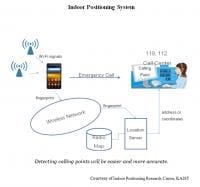
You are going to meet your friends after shopping but just can’t find them in the labyrinth of stores in a shopping mall – This may be a thing of the past as our cell phones are equipped with a more accurate and easy-to-use indoor positioning system.
Cell phones are getting ever smarter today, savvy enough to tell you where to go and what to buy in shopping centers or department stores. Although still in nascent stages, indoor positioning and navigation using mobile phones will be arriving anytime soon.
People widely rely on the Global Positioning System (GPS) for location information, but unlike outdoor environments, GPS does not work well in indoor spaces or urban canyons with streets cutting through dense blocks of high-rise buildings and structures. GPS requires a clear view to communicate with satellites because its signals become attenuated or scattered by roofs, walls, and other objects. In addition, GPS is only one-third as accurate in the vertical direction as it is in the horizontal, thus impossible to locate a person or an object in the floors of skyscrapers.
For indoor positioning, location-based service providers including mobile device makers have mostly used a combination of GPS and wireless network system such as WiFi, cellular connectivity, Ultra Wide Band (UWB), or Radio-frequency Identification (RFID). For example, the WiFi Positioning System (WPS) collects both GPS and WiFi signals, and many companies including Google and Apple utilize this technology to provide clients with location information services.
Professor Dong-Soo Han from the Department of Computer Science, KAIST, explained, “WPS is helpful to a certain extent, but it is not sufficient because the technology needs GPS signals to tag the location of WiFi fingerprints collected from mobile devices. Therefore, even if you are surrounded in rich WiFi signals, they can be useless unless they are accompanied with GPS signals. Our research team tried to solve this problem, and finally we came up with a radio map that is created based on WiFi fingerprints only.”
Professor Han and his research team have recently developed a new method to build a WiFi radio map that does not require GPS signals. WiFi fingerprints are a set of WiFi signals captured by a mobile device and the measurements of received WiFi signal strengths (RSSs) from surrounding access points at the device. A WiFi radio map shows RSSs of WiFi access points (APs) at different locations in a given environment. Therefore, each WiFi fingerprint on the radio map is connected to location information.
The KAIST research team collected fingerprints from users’ smartphones every 30 minutes through the modules embedded in mobile platforms, utilities, or applications and analyzed the characteristics of the collected fingerprints. As a result, Professor Dong-Soo Han said, “We discovered that mobile devices such as cell phones are not necessarily on the move all the time, meaning that they have locations where they stay for a certain period of time on a regular basis. If you have a full-time job, then your phone, at least, have a fixed location of home and office.”
By taking smartphone users’ home and office address as location reference, Professor Han classified fingerprints collected from the phones into two groups: home and office. He then converted each home and office address into geographic coordinates (with the help of Google’s geocoding) to obtain the location of the collected fingerprints. The WiFi radio map has both the fingerprints and coordinates whereby the location of the phones can be identified or tracked.
Read more . . .
via Korea Advanced Institute of Science and Technology (KAIST)
The Latest Streaming News: Indoor positioning updated minute-by-minute
Bookmark this page and come back often
Latest NEWS
Latest VIDEO








